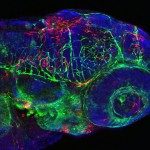Link to Pubmed [PMID] – 21720676
Biol. Res. 2011;44(1):7-15
Copper is an essential ion that forms part of the active sites of many proteins. At the same time, an excess of this metal produces free radicals that are toxic for cells and organisms. Fish have been used extensively to study the effects of metals, including copper, present in food or the environment. It has been shown that different metals induce different adaptive responses in adult fish. However, until now, scant information has been available about the responses that are induced by waterborne copper during early life stages of fish. Here, acute toxicity tests and LC50 curves have been generated for zebrafish larvae exposed to dissolved copper sulphate at different concentrations and for different treatment times. We determined that the larvae incorporate and accumulate copper present in the medium in a concentration-dependent manner, resulting in changes in gene expression. Using a transgenic fish line that expresses enhanced green fluorescent protein (EGFP) under the hsp70 promoter, we monitored tissue-specific stress responses to waterborne copper by following expression of the reporter. Furthermore, TUNEL assays revealed which tissues are more susceptible to cell death after exposure to copper. Our results establish a framework for the analysis of whole-organism management of excess external copper in developing aquatic animals.

